View current page
7 matchs for attack+of+the+clones:
Attack of the Clones, Part 5

Klaus Mosettig (born 1975), Processual Minimalism, 2006, a colony of forest ants constructing a hill. (via VVork)
From The Lives of a Cell, by Lewis Thomas, 1974:
A gallery in New York exhibited a collection of 2 million live army ants, on loan from Central America, in a one-colony show entitled "Patterns and Structures." They were displayed on sand in a huge square bin, walled by plastic sides...Previous clones
[...]
I learned that the army ants had all died.
[...]
There was no explanation, beyond the rumored, unproved possibility of cold drafts in the gallery over the weekend. Monday they were moving sluggishly, with less precision, dully. Then, the death began, affecting first one part and then another, and within a day all 2 million were dead...
[...]
It is a melancholy parable. I am unsure of the meaning, but I do think it has something to do with all that plastic--that, and the distance from the earth.
Attack of the Clones, Part 4
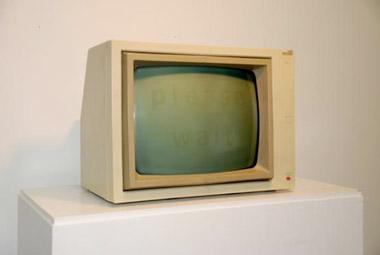
Steven Read, Please Wait, 2005 (via VVork)
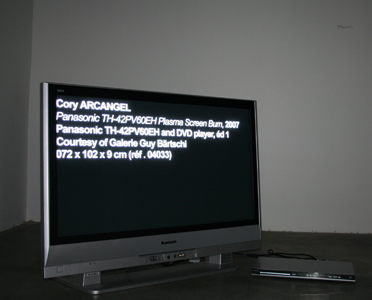
Cory Arcangelís Panasonic TH42PV60EH Plasma Screen Burn, 2007 (also via VVork)
Bonus: Nominee for Worst Theoretical Justification for an Artwork in 2007
from T.Whid:
Arcangelís "Panasonic TH42PV60EH Plasma Screen Burn" is brash and bold, it says "fuck you, Iím fucking up this expensive piece of equipment. Why? Because Iím motherfucking Cory Arcangel thatís why!" Steven Read's piece is nitpicky and fussy. His piece says ďlook! I wrote a program to destroy an obsolete piece of hardware. Why? Because Iím a geek." Arcangelís piece is about fucking with consumer dreams. Read's piece is aboutÖ time and phosphors?I would personally like to see Arcangel going back to destroying obsolete pieces of hardware instead of acting like a jaded rock star. I know some artists who could do some cool things with that plasma screen. (Also, we're taking it on faith that the screen is actually destroyed--in any case, if the gallery sells it, it's contractually tied up as an expensive name plate, which is practically the same thing.)
Previous clone attacks
1987 - Chris Burden's All the Submarines of the United States of America
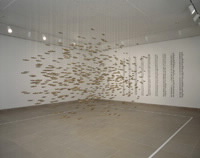
2006 - Fiona Banner's Parade

Thanks to Sally McKay for making me aware of Banner's collection of modeled fighter aircraft from all over the world, which will be shown soon in Toronto. It's the latest in our ongoing "attack of the clones" series.
Updated re: installation schedule.
Anxiety of Influence
1999
Kristin Lucas, mousepad drawings.
Lucas inked a mouseball and let it make gestural drawings while she played games, answered email, etc.
2006
Eyebeam Open Lab - mousepad paintings
Similar gesture paintings made with a USB "double mouse"
(hat tip to jim bassett--demoted from "attack of the clones" to "anxiety of influence" since the Lucas was part meat-space, part virtual and the double mouse is all virtual. it is basically the same idea, though)
Update: another mouse doing "automatic writing," by Joseph DeLappe, from '99 (thx to ed halter)
Update 2: Some critical musings on all this are here.
Attack of the clones, part 2
This item just appeared in Artnet News; apparently "anonymous" shows are happenin':
"ANONYMOUS" ART SHOW IN FRANKFURT The Schirn Kunsthalle in Frankfurt is set to roll out "Anonymous: In the Future No One Will Be Famous," Oct. 31, 2006-Jan. 14, 2007. Organized by an anonymous curator and featuring a selection of anonymous artists (they have agreed not to reveal their identities for the duration of the show), the exhibition is a reaction to what participants describe as the pernicious branding of artists in the contemporary art world.Harlem's Triple Candie gallery also did an "anonymous" series in 2004 and 2005, consisting of two shows by artists whose identities won't be revealed (ever, according to co-gallerist Peter Nesbett.) The curatorial intent was essentially the same--"reaction to pernicious branding of artists in the contemporary art world"--although Triple Candie framed it more thoughtfully as an issue of "how biography informs interpretation." The shows weren't obscure: one was reviewed by Ken Johnson in the New York Times and the gallerists mentioned them in an interview they gave in Flash Art interview in this summer.
The artists have even published "Notes toward a Manifesto" (of anonymity, presumably), declaring, that "Anonymous artists wish to wriggle the status quo into a status incognitus. Their aim is to remove the increasing barbarization of thought via short circuits and fast lanes created by the marketing of artists as brands whose works have become masterpieces in ignorance of philosophy." Also available is a 160-page catalogue, edited by "anonymous" and Max Hollein -- as well as a limited-edition run of 500 catalogues with pages that are completely blank.
While it appears the Schirn Kunsthalle either doesn't read the art press or is, um, appropriating another gallery's recently-promoted concept, the affront may not be all that severe. The fact that the Kunsthalle's artists will be revealed at the end of the show makes it more of a coy guessing game, or publicity stunt, than any kind of transgressive curatorial effort.
Attack of the clones, part 1
Update: from curating.info (the exact link is bloggered): "dear tom moody, see the catalog to the exhibition, page 19. in an interview, the anonymous curator cites this Triple Candie exhibition as being one of the many predecesors of this anonymous show. [...]" -- tom about Curated by "Anonymous" Sat, 11.11.2006 16:35
Attack of the Clones
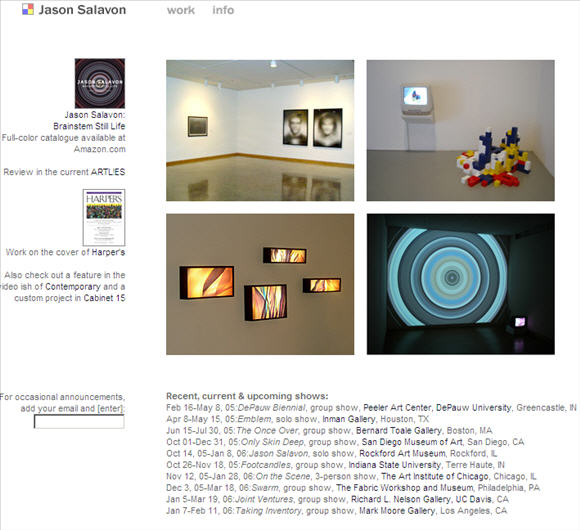
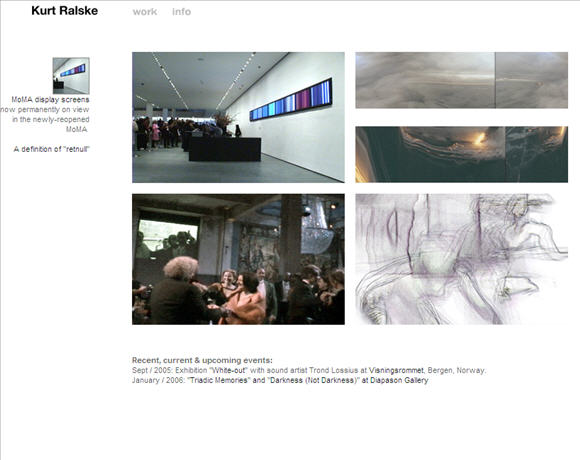
Scott Hug's exhibit "K48: Teenage Rebel: The Bedroom Show," which I mentioned in a previous post, was extended until February 16, so I was able to see it. The theme is "a teenager's bedroom," and the artist (who's in his 30s) is living in the room while the show is up. In addition to floor-to-ceiling posters, photos, and artwork, there's a CD player surrounded by piles of discs, two TVs going most of the time, a dilapidated bed, desk with computer, knickknack covered bureau. Some of it's art (by Hug and others), some of it's kitsch collectibles (heavy on the '80s), some of it's documentation of the NY club scene. The show is so visually dense that you just stand there for a long time gawking. I picked up a checklist but immediately gave up even trying to identify work that way. As soon as Hug was free he was a helpful guide. Here's a microscopically partial list of stuff he showed me (or I picked out myself): video of charged moments from teen films (with Molly Ringwald, Tatum O'Neal etc, and lots of shooting and screaming); Teen Steam, an '80s exercise video featuring a young, big-haired Alyssa Milano; photo of boys from Annandale High School (Northern Virginia--go Atoms!) and related portraits by Lucien Samaha; Hug's polaroids of Electroclash stars PFFR, W.I.T., Kid America, and assorted Williamsburg scenesters; collection of Star Trek TNG cards in ring binder; large plastic Imperial Walker; hermetic neo-alchemical drawing by Jesse Bransford; framed psychedelic computer abstraction by Claire Corey; Italian Escape from New York movie poster; BB gun leaning in corner; photo of shirtless kid holding semiautomatic weapon in liquor store; photo of naked kid holding erect cock; clunky hand-painted portrait of Michael Jackson; weirdly-colored plastic Mickey Mouse manufactured in Russia; brand new C3PO action figure; lots of really crude, fucked up-looking collages; collection of plastic horses and Tracy Nakayama nude girl (on bureau); back issues of Hug's magazine K48. Supposedly there was a Rachel Harrison piece in there, but you'd be slow to identify it in an installation that resembled her own kitsch jamborees of yesteryear, multiplied by ten (but much rawer than her rigorously mathematical mind would allow).
A highlight of my visit was watching a video called The Kid's Show--an actual, slickly produced pilot for the USA Network that was one of the more uncompromising things I've seen on commercial video. The content was so dark and strange (albeit sidesplittingly funny) that it was immediately rejected by the network 3 years ago--I'm not sure Comedy Central, or anything short of MOMA, would take it now. Imagine a cross between ZOOM, Bowling for Columbine, and '70s countercultural skit movies and you're in the general neighborhood--what's "censorable" about it is that kids are speaking some very adult lines. Highlights include a segment called "You Can't Film Here," where a Cookie Monster-like hand puppet awakens the slumbering rageoholics in a succession of very scary New York doormen, a montage called "Funny/Not Funny" with turkey decapitations and reverse motion clown vomiting juxtaposed with violent cartoons, and one of my favorite bits, "Beat Kids," where a cute moppet in blond braids does Tom Green-style interviews with men and women coming out of public restrooms. Wagging a microphone in their faces and smiling guilelessly, she asks questions like "Did you have a good time in there?" and "Did everything come out all right?"
I disagree with the New Yorker that Hug's show is mainly, or merely, nostalgic. The old Dan Hicks song "How Can I Miss You When You Won't Go Away?" comes to mind, in that most of the stuff in the show, representing the perpetual state of adolescence acted out in Pop Culture America, never actually recedes far enough in our memories to become sentimentalized. And what, besides increasingly marginalized "upper class" arts such as the ballet and symphony, constitutes an "adult" activity in this country, anyway? 30somethings queue up for Episode II: Attack of the Clones and anyone who's worked the temp circuit in NYC has possibly had the misfortune of sitting next to a 50 year old singing along with "Another One Bites the Dust" on his Discman. By building up layer upon layer of layer of pop references, "K48" makes it difficult to draw any kind of line concerning where an artist's irony (adulthood) leaves off and the "real thing" (kid culture) begins (you could do it object by object, of course, but that would take a very long time). Hug intensifies a condition that for most of us is just a constant fact of life.
And I disagree with the various NY Times critics' characterizations of this work as "fluffy" or lacking ideology. A useful addendum to Roberta Smith's piece on the youthquake of fun, handmade art in NY would be a compare-and-contrast on this show and Laura Parnes' recently-closed "Hollywood Inferno" video, which didn't quite fit Smith's thesis. While Hug is dealing with (among other things) how youth culture is marketed and continues to colonize our imaginations to our graves, from Parnes' perspective, we never actually get to be young because the emblems of sex, rebellion, and escape are commodified and sold to us from birth. Either way, resistance to the monoculture is futile, the best you can hope for, as an artist, is to do "your" thing and then say yes or no when the USA Network decides to embrace it.
